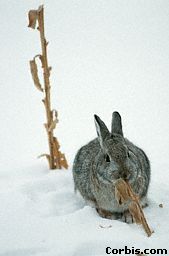

 Habitat loss causes problems for many species, as human populations grow and
city limits expand. According to Wildlife Habitat Canada (1995), agricultural development,
and industrial and residential development at the edge of growing cities, are the main
causes of wetland loss. This is true of other habitat types as well. Villafuerte et al.
(1997) discuss the effect of a smaller habitat on New England cottontails (Sylvilagus
transitionalis.) They compared rabbits in large and small habitats, greater than five
and less than three hectares respectively, and captive rabbits. They used the urea
nitrogen to creatinine (UN:C) ratio as an indicator of the rabbits' nutrition. Villafuerte
et al. found that the captive rabbits had the highest UN:C ratios, and were
therefore the healthiest. They found that rabbits on large patches of habitat were
healthier than those on small patches. Also, more rabbits on small patches were killed
than on large patches, and they tended to be killed sooner. The authors suggested the
rabbits on small patches of habitat depleted their food supply sooner and were forced to
eat lower quality food, or to search for food in areas where there was more risk of being
killed by a predator.
Habitat loss causes problems for many species, as human populations grow and
city limits expand. According to Wildlife Habitat Canada (1995), agricultural development,
and industrial and residential development at the edge of growing cities, are the main
causes of wetland loss. This is true of other habitat types as well. Villafuerte et al.
(1997) discuss the effect of a smaller habitat on New England cottontails (Sylvilagus
transitionalis.) They compared rabbits in large and small habitats, greater than five
and less than three hectares respectively, and captive rabbits. They used the urea
nitrogen to creatinine (UN:C) ratio as an indicator of the rabbits' nutrition. Villafuerte
et al. found that the captive rabbits had the highest UN:C ratios, and were
therefore the healthiest. They found that rabbits on large patches of habitat were
healthier than those on small patches. Also, more rabbits on small patches were killed
than on large patches, and they tended to be killed sooner. The authors suggested the
rabbits on small patches of habitat depleted their food supply sooner and were forced to
eat lower quality food, or to search for food in areas where there was more risk of being
killed by a predator.
Villafuerte et al. showed that rabbits have a better chance of surviving on larger habitat patches. This is true for other species: many conservationists believe that habitat fragmentation is the greatest threat to biodiversity (Wildlife Habitat Canada, 1995.) Small patches of habitat may be surrounded by cultivated land, where there are fewer resources available and the organisms have less protection from predators (Wildlife Habitat Canada, 1995.) With forests fragmented into small patches, there may be all forest "edge." Certain species require a forest interior, and therefore a larger patch of forest (Wildlife Habitat Canada, 1995.) Certain species also need more than one patch of their preferred habitat, since resource availability varies over time and space. Other species move between different habitats, and they need a safe path from one habitat patch to another (Wildlife Habitat Canada, 1995): cultivated land may not provide enough cover.
 A conservationist interested in sustaining populations of New England
cottontails, or other species, would have to be concerned about more than just the number
of individuals in a population. They would have to ensure the habitat was large enough for
the species to survive. If a conservationist used captive breeding or other methods to
increase the numbers of a species, then released them into a habitat that was too small to
ensure their survival, their work would be for nothing. Conservationists must work towards
protecting large areas of land to protect the species living there (Wildlife Habitat
Canada, 1995). If humans continue to fragment habitats, the organisms may some day have
nowhere left to go.
A conservationist interested in sustaining populations of New England
cottontails, or other species, would have to be concerned about more than just the number
of individuals in a population. They would have to ensure the habitat was large enough for
the species to survive. If a conservationist used captive breeding or other methods to
increase the numbers of a species, then released them into a habitat that was too small to
ensure their survival, their work would be for nothing. Conservationists must work towards
protecting large areas of land to protect the species living there (Wildlife Habitat
Canada, 1995). If humans continue to fragment habitats, the organisms may some day have
nowhere left to go.
References
Wildlife Habitat Canada. 1995. Saving Species: Building Habitat into Endangered Species Conservation in Canada. Wildlife Habitat Canada, Ottawa.
Villafuerte, R., J. A. Litvaitis and D. F. Smith. 1997. Physiological responses by lagomorphs to resource limitations imposed by habitat fragmentation: implications for condition-sensitive predation. Canadian Journal of Zoology, 75:148-151.
Fall 1998
| Home | Chemistry | Physics | Astronomy | Biology | Ecology |
| Geography | Medicine | Mathematics | Technology |
| Issues | Scientists | General | Reference |
Last Updated Sunday, August 26, 2007 23:50 -0400
� Suzanne P. Currie 1999 [email protected]